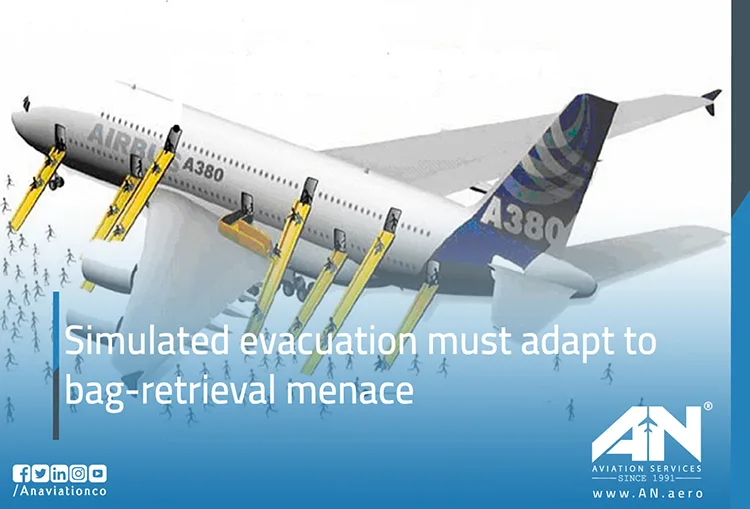
Emergencies on an aircraft demand swift and efficient action. Passengers, flight crew, and emergency responders must all navigate chaotic situations to ensure the safety of everyone onboard. One significant concern that has surfaced in recent years is the growing trend of passengers prioritizing their personal belongings during emergency evacuations. This issue not only poses a risk to their safety but also jeopardizes evacuation times for others. To address this modern menace, simulated evacuations must evolve to include realistic scenarios that account for this behavior.
By leveraging advancements like FDS Evac modeling, analyzing fluid dynamics, and rethinking training protocols, the aviation industry can better prepare for emergency evacuations and reduce risks associated with bag retrieval. Let’s take a closer look at how these changes can improve safety.
The Challenge of Bag Retrieval During Evacuations
Despite repeated warnings and instructions from cabin crews, passengers often attempt to retrieve carry-on bags during emergencies. This behavior can drastically slow down emergency evacuations, putting lives at risk. While airlines emphasize the importance of leaving belongings behind, many passengers fail to grasp the urgency of the situation, prioritizing their personal items over their own safety.
Retrieving bags during evacuations creates several risks:
- Obstructed Exits: Passengers digging through overhead bins can block aisleways, delaying others trying to reach emergency exits.
- Injury Risks: Heavy luggage and hasty movement can lead to injuries for both passengers and crew.
- Increased Evacuation Times: Every second counts during an evacuation. The extra time spent on bag retrieval can cost lives, especially in smoke-filled or fire-prone situations.
Why Simulated Evacuations Must Evolve?
Standard simulated evacuations, which are part of regulatory safety protocols, typically do not include the complexities of real-world passenger behavior. These tests aim to assess the ability of passengers to exit the aircraft in 90 seconds, as required by the Federal Aviation Administration (FAA) and other governing bodies. However, the focus is often on optimal conditions, such as no luggage retrieval or perfectly functioning exits.
To address the bag-retrieval menace, simulated evacuations should incorporate:
- Behavioral Elements: Training simulations should reflect real-life scenarios, including passengers attempting to grab personal belongings.
- Congestion Management: Testing how passengers navigate around obstructions caused by bag retrieval can help optimize evacuation routes.
- Fluid Dynamics Analysis: Incorporating fluid dynamics can provide insights into passenger flow, bottlenecks, and the impact of various behaviors during evacuations.
By accounting for these factors, airlines and regulators can better understand and mitigate the risks posed by passenger behavior.
Leveraging FDS Evac for Realistic Simulations
One promising tool for improving simulated evacuations is FDS Evac. This advanced simulation software uses computational fluid dynamics to model passenger flow during emergency situations. By analyzing movement patterns, congestion points, and the influence of behaviors like bag retrieval, FDS Evac can provide valuable data to enhance evacuation planning and training.
Some of the key benefits of using FDS Evac include:
- Accurate Passenger Behavior Modeling: Simulating realistic scenarios, including delayed movement due to luggage retrieval, allows for more precise evacuation strategies.
- Optimized Exit Strategies: The software helps identify the best use of available exits based on passenger flow and aircraft layout.
- Predictive Analysis: FDS Evac can predict how changes to cabin design, seating arrangements, or crew protocols might impact evacuation times.
Incorporating FDS Evac into regulatory tests and airline training programs can help bridge the gap between theoretical simulations and real-life emergencies.
The Role of Fluid Dynamics in Evacuation Planning
Fluid dynamics, a field traditionally associated with aerodynamics and engineering, plays a critical role in understanding passenger flow during evacuations. In the context of emergency evacuations, passengers are treated as particles in a flowing system. Using fluid dynamics models, researchers can simulate the movement of passengers through narrow aisles and towards exits.
By analyzing evacuation patterns, airlines can:
- Identify choke points where passenger flow is likely to slow down.
- Test the impact of different seating layouts and cabin configurations on evacuation efficiency.
- Evaluate how passenger behavior, including bag retrieval, disrupts flow and increases evacuation times.
These insights are crucial for developing better evacuation procedures, improving cabin designs, and reducing the risks associated with delayed exits.
Revisiting Passenger Education and Training
While improving simulated evacuations and leveraging technology like FDS Evac are essential, passenger education also plays a vital role. Airlines must intensify efforts to educate passengers on the dangers of retrieving luggage during emergencies. Clear communication and repeated emphasis on leaving bags behind can make a significant difference.
Effective strategies include:
- Pre-Flight Announcements: Reinforcing the importance of prioritizing safety over belongings during emergencies.
- Safety Videos: Creating engaging safety videos that depict the risks of bag retrieval.
- Visual Cues: Using posters and signage throughout the aircraft to remind passengers to leave personal items behind.
Training cabin crews to handle passengers who attempt to retrieve bags is equally important. In high-stress situations, crew members must be prepared to enforce safety protocols while maintaining calm and control.
The Way Forward: A Collaborative Approach
The aviation industry must adopt a collaborative approach to address the challenges posed by bag retrieval during evacuations. This includes:
- Regulators and Airlines Working Together: Updating evacuation certification tests to reflect real-world passenger behavior.
- Incorporating Advanced Technology: Using tools like FDS Evac and fluid dynamics to improve evacuation planning.
- Ongoing Research: Conducting studies on passenger behavior during emergencies to inform better training and design practices.
Ultimately, ensuring passenger safety requires a combination of realistic simulations, advanced modeling tools, and effective education. By adapting to the challenges posed by modern passenger behavior, the aviation industry can reduce evacuation risks and save lives.
Conclusion
The issue of passengers retrieving luggage during evacuations is a serious concern that cannot be ignored. By evolving simulated evacuations to reflect real-world scenarios, leveraging tools like FDS Evac, and prioritizing passenger education, the aviation industry can take significant steps toward enhancing safety.
Emergencies are unpredictable, but with the right strategies and technologies, airlines can ensure that passengers and crew are better prepared to navigate these high-stakes situations. The key lies in bridging the gap between simulation and reality—ensuring that every evacuation is as efficient and safe as possible.




